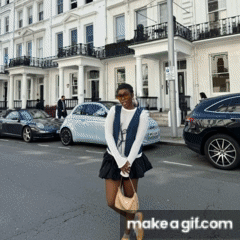
The editors at fashion publications and influencers on Instagram who decided what the taste was were losing their grip on their audience in an increasingly digitalised media landscape.
Then the pandemic happened in 2020 and the lives of many turned into an endless loop of the TV show, Get Me Out of Here.
On social media, jaded by income inequality, bringing down capitalism was the order for months. There were talks about the colonial apparatus, police brutality and claims that the media establishment had for decades sidelined marginalised people from conversations around fashion and beauty.
So they left Instagram and went to TikTok, where they could see themselves in the content and joined communities of like-minded people.
There were tons of skits about living below the poverty line. Rather than build followers to whom a false life in which every day was a day for full makeup, tight designer clothes and vacation, these TikTok creators built communities trying desperately to be as working class as possible.
While the fashion influencers on Instagram took a thousand baths at the beaches of Saint Tropez, and sat in front-row seats during fashion week, on TikTok the barriers to fashion influencing, once very high, were beginning to crumble. These influencers didn’t need fashion brands to send them exclusive drops. Many of them would not have been caught dead at any fashion week event anyway.
But after the pandemic and the exponential rise of fast fashion, they began a new kind of fashion influencing, offering attainable style tips for everyday living. Their videos showed them in everyday looks and not high-end fashion brands. They didn’t post pictures in old European cities. They stormed the streets of Lagos making skits, dance videos and transition videos. And so advertisers naturally choose them.
In May 2022, the footwear brand Crocs announced Adeoluwa Enioluwa, who rose to fame by posting commentary and eating humongous meals on Instagram, as its first Nigerian brand ambassador. He now has 2.5 million followers and is one of the country’s biggest lifestyle influencers.
How did the Nigerian fashion establishment go from shopping in empty streets in Paris to get-ready-with-me videos in tiny Lagos BQs?
“Everybody is focused on community development because Meta [Instagram’s parent company] has shifted their own design to be more focused on community,” Lade Adisa, the editor of BellaNaija Style told Pulse Nigeria. “So if you’re not paying to play, the other way you can grow on these social media platforms is to build a community. And because of that, brands have seen that there is more power in investing in an influencer that has a genuine organic community, than giving a big name that has no touch with their audience.”
The core of this shift is not that the influencers of yore lost their followers per se. Stars of that era of Instagram fashion, Kehinde Smith, IamDodos and Shirley Eniang remain active online, occasionally making comebacks and then disappearing for months. But their growth has stunted. Among the three aforementioned, Eniang has the most followers with 377,000. Bukunmi Adeaga-Ilori, the vivacious fashion influencer popularly known as Kiekie, who now hosts red-carpet events and has landed acting gigs, has over 3.5 million followers on Instagram.
As years went on, the reputation that had shrouded these influencers as the perfect definition of class and style began to look more like a facade for a life as mundane as everyone else.
The beauty influencer, Ronke Raji, for instance, came under heavy criticism for a post she made during Nigeria’s EndSARS protests in 2020. She posted a picture of herself in front of a bicycle, which would have been the typical fashion influencer post. But her caption, which was largely about her love for riding bicycles, ended with the protest.
“Right now in Nigeria SARS (Special Anti-Robbery Squad) needs to be under investigation because of the brutality to civilians. This has been going on for as long as I lived there. Please be aware and let’s band together for a change in this current climate,” she wrote. Critics said she had hijacked the protest to promote herself, living in endless luxury. She has since apologised for the incident.
But even as Raji posted that bicycle photo and many cute couple photos with her husband, Arthur Adeola, the life she curated for the public was far from perfect. In 2023, the influencer announced her separation from Adeola, alleging incidents of emotional and physical abuse.
Smith and her then-boyfriend, Marek Zmyslowski, who graced the cover of Genevieve Magazine in a spread called “The Power of Love,” also faced a brutal public breakup. She had also posted photos with Zmyslowski on Instagram, selling the story of the ideal power couple – the woman, a high-flying businesswoman and the man, a young successful entrepreneur.
Also, she had made comments that sought to diminish the humanity of people who didn’t flaunt expensive luxury items on social media. In one X post years ago, Smith called the customers of an Instagram handle that pretended to be My Extensionz, the beauty brand she started with her sister Taiwo Smith, “silly rabbits.”
They were trying to buy what she was selling at a cheaper price.
“Big brands are more interested in investing in somebody that has maybe 10,000 followers but is in touch with those 10,000 followers,” Adisa said. “They trust their opinion. When that person says ‘Ooh I love this,’ maybe 1,000 capable people within the community will go ahead and buy that product. That is why we are seeing more of that influx of genuine connection, and authenticity. People are coming down from their high horse to actually get in touch with their fans.”
But these days, the gatekeepers, who decided who should be allowed into society have mostly shifted their focus to accommodate the new elites or left the party altogether.
“Because of all the things that have happened, everybody has come to a place where you cannot deny that inclusivity is important. So every brand, even the brands that sold themselves as not being inclusive, for a particular niche of people, are now seeing that that is to their disadvantage,” Adisa said.
“Everybody sees the value in being inclusive and diverse. As a fashion journalist, we know that we have to show we are open to different types of people, beauty standards, and fashion tastes. People want originality. People want authenticity.”
Some of the fashion influencers are adapting, combining nine to five jobs with their content, and posting videos in a more familiar state. Last month, Asiyami Gold posted a video of herself in the village, dancing without makeup, in a black T-shirt and a wrapper on her waist. It is how anyone would have looked if they were also in the village. The walls of the house were unpainted and rubbish dotted the compound. That post has over 17,000 likes. Another post she made around the same time, a fashion Reel, has just under 4,000 likes.
For Adisa, content monetisation, which is the point of all of this anyway, is what will decide the future of the space.
“Money moves the world. Money is a game changer. No matter what good these people have done in the past, when money is no longer flowing in that direction, they need to rethink. The shock of everything changing can be really hard, but we need to come to a point of acceptance,” she said.
 Top Naija News – Nigeria News, Nigerian News & Top Stories Top Naija News – Nigerian Newspapers, Nigerian News. topnaijanews is a daily Nigerian newspaper covering Latest News, Breaking News, Entertainment, Sports, Lifestyle and Politics.
Top Naija News – Nigeria News, Nigerian News & Top Stories Top Naija News – Nigerian Newspapers, Nigerian News. topnaijanews is a daily Nigerian newspaper covering Latest News, Breaking News, Entertainment, Sports, Lifestyle and Politics.




